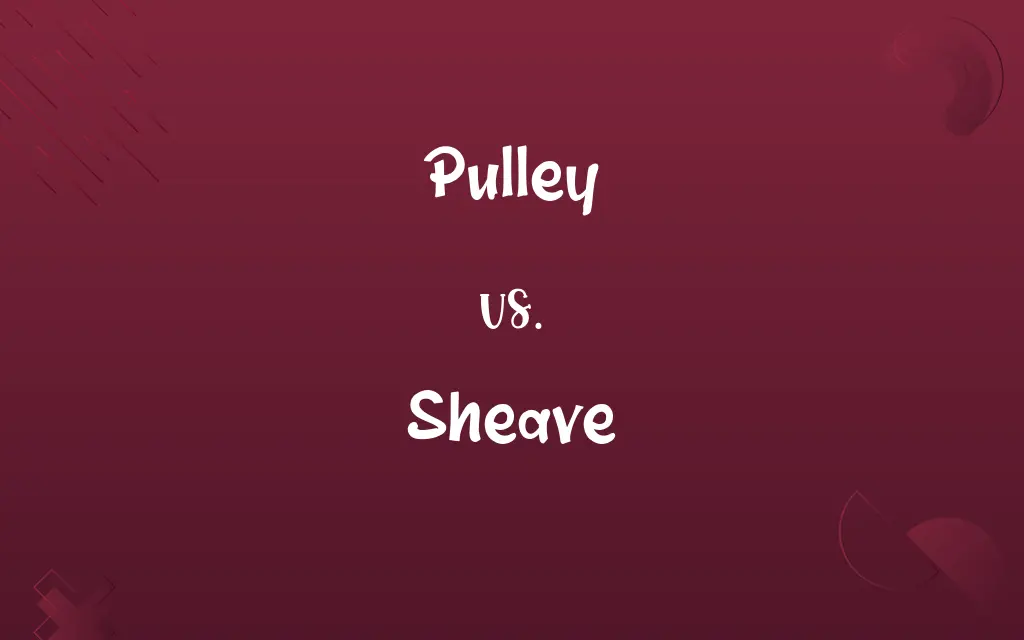Pulley vs. Sheave: Know the Difference

By Hifza Nasir & Shumaila Saeed || Published on April 4, 2024
A pulley is a wheel on an axle designed to support movement and change of direction of a taut cable, while a sheave is the wheel part of a pulley system that specifically interacts with the cable.

Key Differences
Pulleys are fundamental mechanical devices used in various applications to change the direction of force and potentially multiply its effect. A pulley consists of a wheel on an axle or shaft, designed to support the movement and change the direction of a taut cable or belt. The sheave, on the other hand, refers specifically to the wheel or disk within the pulley system that has grooves between flanges around its circumference for holding the cable or belt.
Shumaila Saeed
Apr 04, 2024
The primary function of a pulley is to make lifting weights easier by altering the direction of the force applied. When a person pulls down on one end of a rope in a pulley system, the load on the other end is lifted. Sheaves play a critical role in this system by guiding and holding the rope or cable in place, ensuring smooth and efficient operation.
Shumaila Saeed
Apr 04, 2024
In terms of construction, a pulley can be a simple device with a single sheave, or more complex, consisting of multiple sheaves combined in blocks for heavy-duty applications. Sheaves, being components of pulleys, are designed to fit within these blocks, allowing for flexibility in creating pulley systems of varying mechanical advantage.
Hifza Nasir
Apr 04, 2024
All sheaves are integral parts of pulley systems, not all pulleys are created equal. Some pulleys are fixed, only changing the direction of force, while others are movable, offering a mechanical advantage that reduces the effort needed to lift a load. The sheave’s design, including its diameter and the material it is made from, plays a significant role in determining the efficiency and suitability of the pulley for specific tasks.
Hifza Nasir
Apr 04, 2024
Understanding the distinction between pulleys and sheaves is crucial for selecting the right equipment for lifting and mechanical applications. While the pulley refers to the entire apparatus that facilitates lifting or moving loads with less effort, the sheave is specifically the wheel or disk that directly contacts and guides the rope or cable within the system.
Dua Fatima
Apr 04, 2024
ADVERTISEMENT
Comparison Chart
Definition
A mechanical device used to change the direction of a force applied to a cable or belt.
The wheel or disk part of a pulley with grooves for holding a cable or belt.
Shumaila Saeed
Apr 04, 2024
Component
Consists of a sheave, axle, and sometimes a block for housing.
Is a component of a pulley.
Shumaila Saeed
Apr 04, 2024
Function
Changes direction of force and can multiply force when used in systems.
Guides and holds the cable or belt in a pulley system.
Hifza Nasir
Apr 04, 2024
Types
Fixed, movable, compound.
Varies in diameter, groove size, and material.
Shumaila Saeed
Apr 04, 2024
Application
Used in lifting, lowering, or moving loads.
Specific to the pulley it is part of, affecting the system’s efficiency and capacity.
Hifza Nasir
Apr 04, 2024
ADVERTISEMENT
Pulley and Sheave Definitions
Pulley
Used in various applications from construction to theater.
Pulleys backstage make quick scene changes possible.
Shumaila Saeed
Feb 29, 2024
Sheave
A grooved wheel that interacts with a belt in machinery.
The mechanic adjusted the sheave to align the conveyor belt properly.
Shumaila Saeed
Feb 29, 2024
Pulley
An integral part of mechanical systems for reducing effort.
The engineer designed a pulley system to ease the gate's opening.
Hifza Nasir
Feb 29, 2024
Sheave
The wheel within a pulley that guides a rope or cable.
The sheave wore out and needed replacement to keep the elevator running smoothly.
Hifza Nasir
Feb 29, 2024
Pulley
A wheel and axle mechanism that supports movement of a cable.
The old well used a simple pulley system to draw water.
Hifza Nasir
Feb 29, 2024
ADVERTISEMENT
Sheave
Manufactured in different sizes for specific tasks.
For the new system, a larger sheave was necessary to handle the increased load.
Hifza Nasir
Feb 29, 2024
Pulley
A component in machinery for transmitting power.
The belt runs over a pulley to operate the fan.
Hifza Nasir
Feb 29, 2024
Sheave
Often made from materials like metal or nylon for durability.
The nylon sheave offered a quieter operation in the library's book retrieval system.
Hifza Nasir
Feb 29, 2024
Pulley
A device that changes the direction of force to lift weights.
Using a pulley, the construction workers hoisted the materials to the upper floors.
Hifza Nasir
Feb 29, 2024
Sheave
Critical for the efficiency of pulley systems.
Replacing the sheave improved the crane's lifting performance significantly.
Shumaila Saeed
Feb 29, 2024
Pulley
A simple machine consisting essentially of a wheel with a grooved rim in which a pulled rope or chain can run to change the direction of the pull, for example to lift a load.
Hifza Nasir
Feb 28, 2024
Pulley
A simple machine consisting of a wheel with a groove in which a rope can run to change the direction or point of application of a force applied to the rope
Hifza Nasir
Feb 28, 2024
Sheave
A wheel having a groove in the rim for a rope to work in, and set in a block, mast, or the like; the wheel of a pulley.
Hifza Nasir
Feb 28, 2024
Pulley
One of the simple machines; a sheave, a wheel with a grooved rim, in which a pulled rope or chain lifts an object (more useful when two or more pulleys are used together, as in a block and tackle arrangement, such that a small force moving through a greater distance can exert a larger force through a smaller distance).
Hifza Nasir
Feb 28, 2024
Pulley
A wheel with a broad rim, or grooved rim, for transmitting power from, or imparting power to, the different parts of machinery, or for changing the direction of motion, by means of a belt, cord, rope, or chain.
Shumaila Saeed
Feb 28, 2024
Sheave
A wheel having a groove in the rim for a rope to work in, and set in a block, mast, or similar; the wheel of a pulley.
Hifza Nasir
Feb 28, 2024
Repeatedly Asked Queries
Can a sheave function independently of a pulley?
No, a sheave is a component of a pulley and cannot function independently.
Shumaila Saeed
Apr 04, 2024
What is a sheave?
A sheave is the wheel or disk part of a pulley that has grooves for holding a cable or belt.
Hifza Nasir
Apr 04, 2024
What materials are sheaves made from?
Sheaves can be made from metal, plastic, or other durable materials.
Hifza Nasir
Apr 04, 2024
How does a pulley work?
A pulley changes the direction of the applied force, allowing for easier lifting or moving of loads.
Hifza Nasir
Apr 04, 2024
How do I choose the right sheave for a pulley system?
Consider the diameter, groove size, and material of the sheave based on the load and application.
Hifza Nasir
Apr 04, 2024
What is a pulley?
A pulley is a mechanical device used to change the direction of a force applied to a cable or belt, making it easier to lift weights.
Shumaila Saeed
Apr 04, 2024
Why is the groove size important in a sheave?
The groove size must match the cable or belt to ensure smooth operation and prevent slippage.
Shumaila Saeed
Apr 04, 2024
What are the types of pulleys?
There are fixed, movable, and compound pulleys.
Hifza Nasir
Apr 04, 2024
Can pulleys be used in combination?
Yes, pulleys can be combined in compound systems for greater mechanical advantage.
Hifza Nasir
Apr 04, 2024
How does a pulley system improve work efficiency?
It allows for moving heavier loads with less force, reducing work time and effort.
Shumaila Saeed
Apr 04, 2024
Can the material of a sheave impact the pulley's performance?
Yes, the material affects durability, efficiency, and suitability for specific environments or loads.
Dua Fatima
Apr 04, 2024
Are all sheaves the same?
No, sheaves vary in size, material, and design to suit different pulley systems.
Hifza Nasir
Apr 04, 2024
What's the advantage of using a pulley system?
Pulley systems reduce the effort needed to lift or move loads, making tasks more efficient.
Hifza Nasir
Apr 04, 2024
How do fixed and movable pulleys differ?
Fixed pulleys change the direction of force, while movable pulleys offer a mechanical advantage.
Shumaila Saeed
Apr 04, 2024
What role does the diameter of a sheave play?
The diameter affects the mechanical advantage and efficiency of the pulley system.
Hifza Nasir
Apr 04, 2024
Share this page
Link for your blog / website
HTML
Link to share via messenger
About Author
Written by
Hifza NasirCo-written by
Shumaila SaeedShumaila Saeed, an expert content creator with 6 years of experience, specializes in distilling complex topics into easily digestible comparisons, shining a light on the nuances that both inform and educate readers with clarity and accuracy.






































































